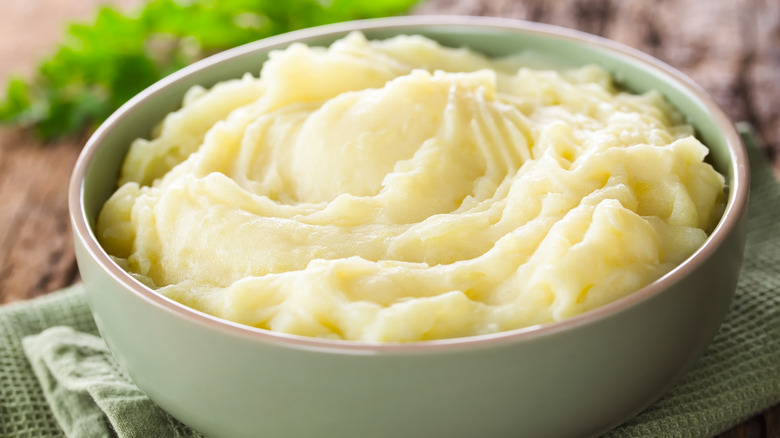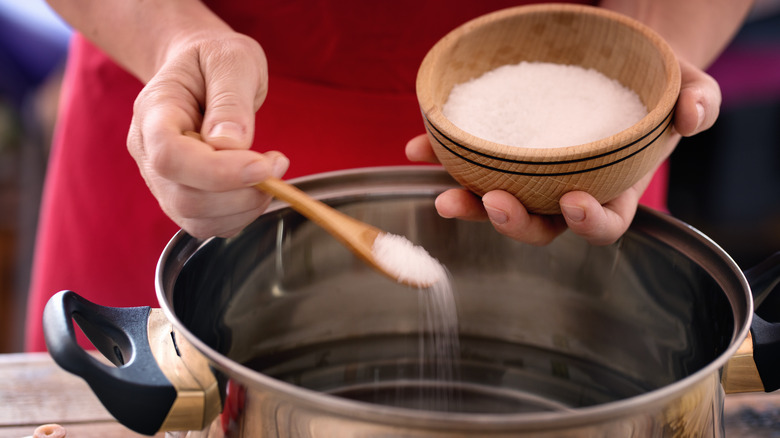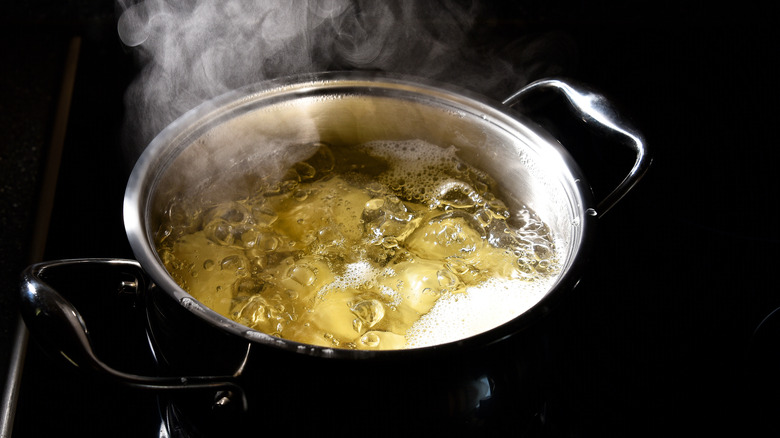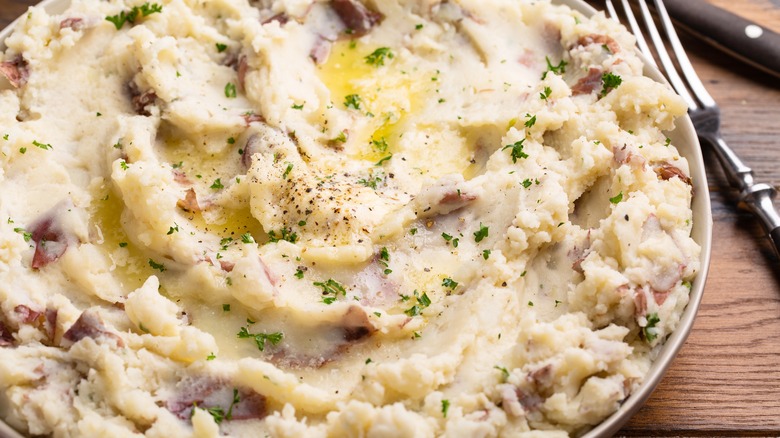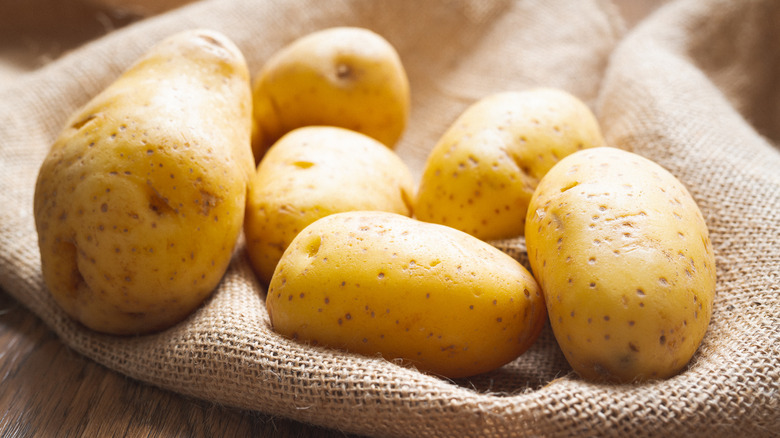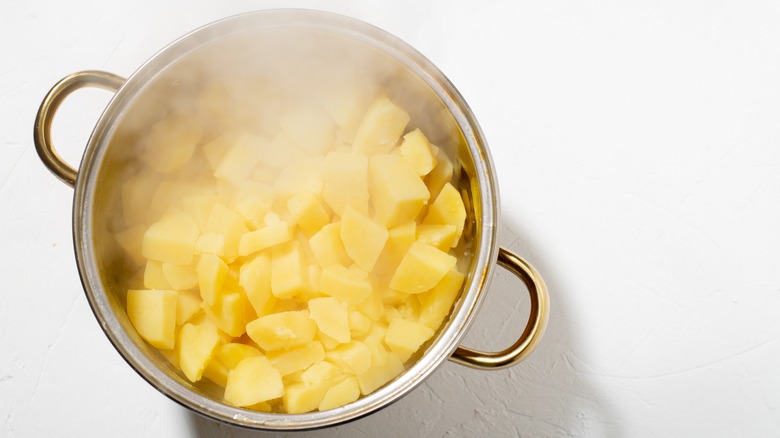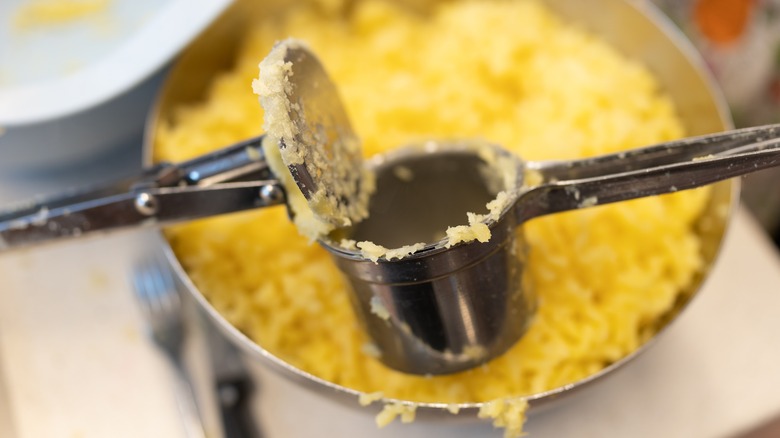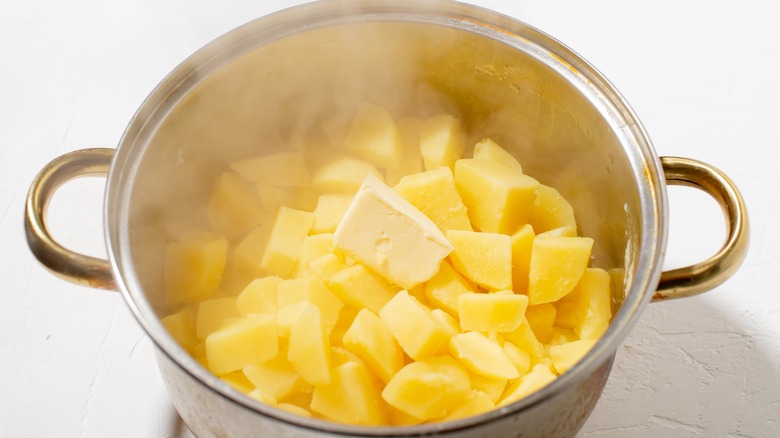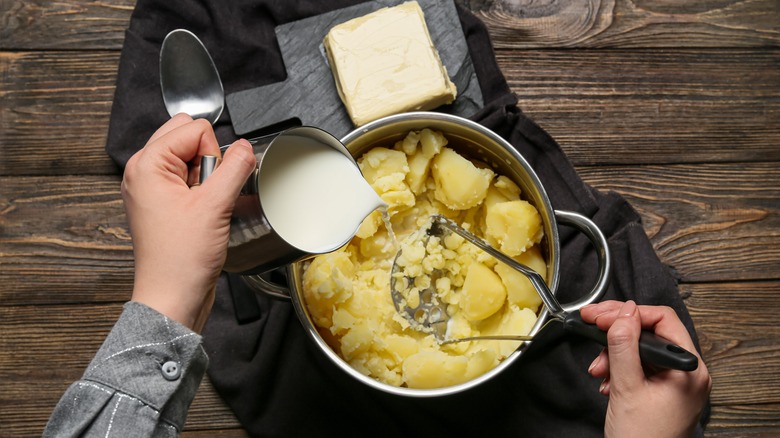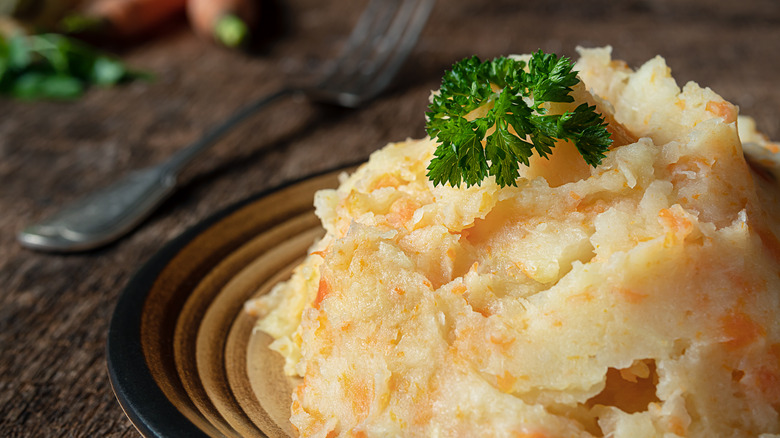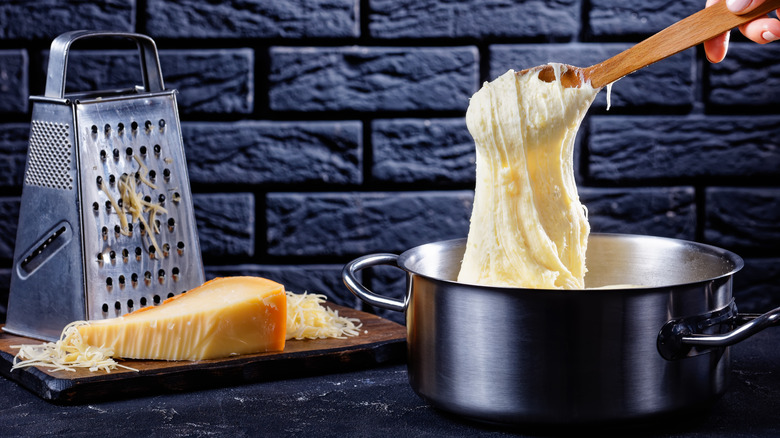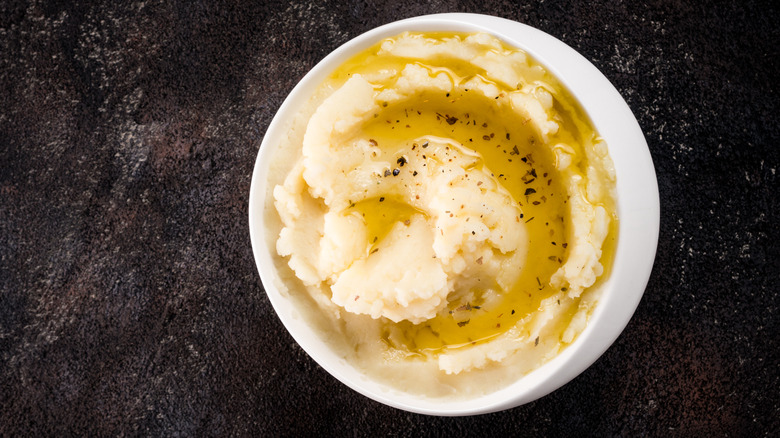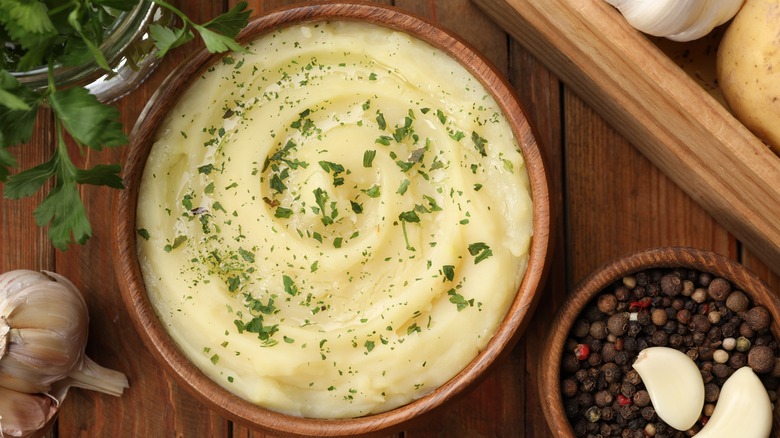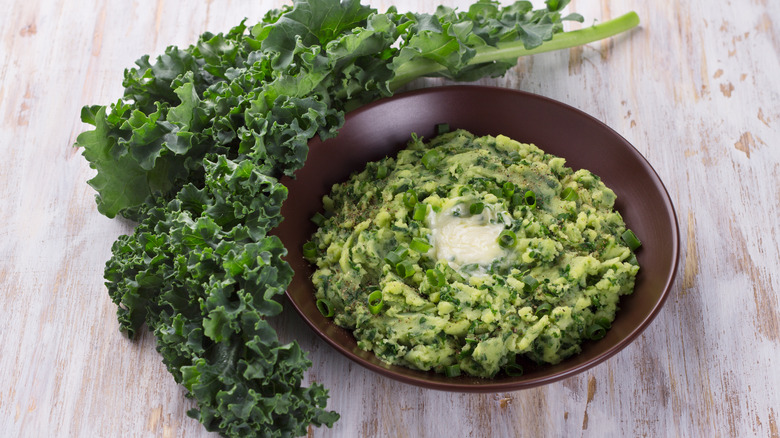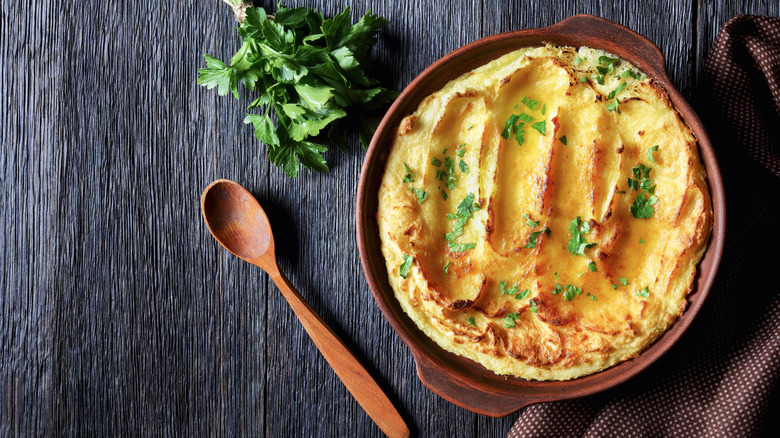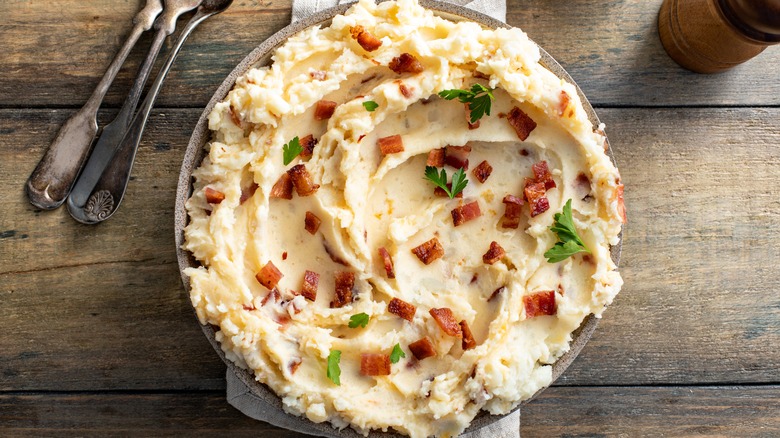16 Tips For Seriously Upgrading Your Mashed Potatoes
The humble potato is one of the most varied and versatile vegetables on the planet. It's part of the tuber family, which means the main edible part of the plant grows underground. Over centuries, potatoes traveled from their native Andes homeland to Europe and beyond. Along the way, they've inspired cooks around the world to utilize their starchy goodness in unique and creative ways, from roasting to baking to frying — and, of course — mashing them.
A creamy, comforting bowl of mashed potatoes is hard to beat, whether you're at the Thanksgiving table, a backyard barbecue, or an intimate dinner date. Mashed potatoes can be rustic and dressed down or elegant and sophisticated, making them the perfect side dish for any occasion.
The mild, neutral flavor of potatoes lets them work well as an accompaniment to a wide variety of foods, from a beautifully seared filet mignon to a bucket of fried chicken. That's not to say, though, that mashed potatoes can't be the main event. If your mashed potatoes are lacking star power, here are some tips to help you give them a major upgrade.
1. Salt everything
Most varieties of potato possess a mild flavor, perhaps with a buttery or earthy quality, but fairly neutral in taste. That makes it extra important to make sure they're seasoned properly with salt, or they can come off as bland and one-dimensional. Getting the right level of seasoning for mashed potatoes takes precision and diligence, and should be assessed and adjusted at every step in the cooking process.
The first step in making mashed potatoes is cooking the potatoes themselves, which is usually done by boiling them. Whatever liquid is used, whether it's water, stock, or something else, it's crucial to ensure it's well-salted. As the potatoes boil, they'll absorb whatever flavors are present in the liquid, and letting their flesh become fully penetrated with salt will guarantee good results.
As you continue preparing your mashed potatoes, each time you add an ingredient, taste and evaluate the salt level. Be particularly aware if you're adding ingredients that are already salty — like salted butter, cheese, bacon, or anything pickled or fermented. It's a delicate balance and you don't want to overdo it.
2. Think beyond water for boiling
If you're going for minimalist mashed potatoes, water is a fine option to use for the initial boiling process (as long as you don't forget to generously salt it). But if you're looking to upgrade the flavor of your mashed potatoes, this step is a great place to start. The potatoes will absorb the flavors of whatever liquid they're boiled in, so just by switching up what you put in the pot, you can immediately add an extra dimension.
Stock is an easy and obvious option. Vegetable, chicken, or beef stock (store-bought or homemade) will each add its unique blend of flavors to the potatoes. To punch up potatoes' natural earthiness, a mushroom stock is a great choice. To make your own, simply reconstitute dried mushrooms in water, boil and simmer, and strain out the solids. If you want to go the extra rich route with your mash, boiling the potatoes in milk will imbue them with a luxuriously creamy taste and texture.
3. Keep the skins on
Not all potato skins are created equal. Depending on which variety of potato you're using for your mash — and what style of dish you're going for — there are pros and cons to leaving the skins on or getting rid of them. But even if you plan on keeping the skins out of the finished dish, there are some good reasons to keep them on during the cooking process.
Starchy potato varieties, such as Russet, have a tendency to absorb a lot of water as they boil. Keeping a Russet's thick skin intact helps to prevent this from happening, which in turn leads to softer, fluffier mashed potatoes rather than a gummy, waterlogged mess. Other types of potatoes, like Yukon Golds, have thinner skins and denser flesh, but keeping the skin on still helps to prevent overcooking in the same way.
Potato skins are arguably easier to remove after the potato has been cooked, so keeping them unpeeled saves time and effort in the long run. The peel should slide off fairly easily from a boiled potato, or you can use a potato ricer which pushes the potato flesh through while leaving the skin behind. Leaving the skin on and mashing by hand will leave you with a more rustic and interesting texture, as well as the added fiber content from the peels, according to Potato Goodness.
4. Go for the gold
You have a lot of choices when it comes to potatoes for mashing. There are several qualities to consider when deciding which variety to select, like size and color, but the most important characteristic is what's under the skin. A good mashing potato needs to have flesh that is dense enough to stand up to cooking, and will maintain a creamy texture even after being smashed, riced, or pureed. It also needs to be able to absorb other ingredients well, like butter and cream, without becoming goopy or gluey.
Out of the major potato varieties, the top two contenders for the crown are Russets and Yukon Golds. While they both contain a decent level of starchiness which translates to a nice and fluffy mashed texture, Yukon Golds' more compact flesh gives them a creaminess and richness that Russets lack, along with a warm, buttery flavor. These golden spuds will give you smooth, satisfying mashed potatoes every time.
5. Get rid of moisture
After boiling your potatoes, there is one very important step is often overlooked by most chefs. It can really make or break your mashed potatoes. As they swim in their simmering liquid, potatoes absorb a lot. When they get mashed, that liquid is released and can water down their texture, leaving them soggy or runny. Then if you try to add more moist ingredients, like milk or cream, it's harder for everything to smoothly combine.
Once your potatoes have boiled enough to be fork-tender, and after they've been drained in a colander, you can then throw them back into the now-empty pot. The residual heat will help any remaining moisture evaporate, and you can even cook them briefly over low heat to make sure they're extra dry. This simple step is commonly skipped but can make a huge difference in improving the texture of your mashed potatoes.
6. Use a food mill or ricer
Texture is an all-important factor when making mashed potatoes. It is as vital as flavor. Using a hand masher or even just a fork is fine if you like a coarse and rugged mashed potato, which can certainly be delicious. But if you want to create the smoothest, fluffiest, most ethereal restaurant-quality mashed potatoes, a few simple and relatively inexpensive tools can help you get there.
A potato ricer is a handheld object that resembles a garlic press but is large enough to process potatoes. You add the cooked potato into the cup portion, which has small holes at the bottom, and press down on the top handle so that the potato is pushed through. The result is tiny, rice-like bits of soft potato that have an airy, fluffy texture when mixed together.
A food mill works in a similar fashion, pushing the potato through small holes. But instead of pressing straight down, it has a crank that you spin by hand, which pushes the food through as it rotates. Food mills are larger and can handle more potatoes at once, while the ricer is best for smaller batches. Both contraptions will leave you with the smoothest, fluffiest mashed potatoes imaginable.
7. Be generous with butter
If you've ever wondered why mashed potatoes taste so much better at restaurants than they do at home, the answer can usually be boiled down to two things: salt and butter. Professional cooks tend to throw these ingredients around far more liberally than a typical home chef, and the results are richer, fattier, more flavorful foods. If you want your mashed potatoes to rival those of a high-end, five-star kitchen, make sure they're well-seasoned and loaded up with butter.
For the richest, most decadent, melt-in-your-mouth mashed potatoes, take a page out of legendary chef Joel Robuchon's book. He famously used a two-to-one ratio of potatoes to butter in his signature pommes puree, according to Food52, mixing in a few cubes at a time to create a silky smooth starch and fat emulsion. That level of extravagance may be too rich for most meals — even cutting it in half will still result in incredibly luxurious potatoes.
8. Add in different kinds of dairy
Along with butter, milk is typically the second added major ingredient in classic mashed potatoes. Half-and-half or cream can be used instead, for extra richness without changing the flavor. The addition of this type of liquid helps to create a smooth, silky texture and allows the cook to adjust the consistency of the dish to their liking.
However, you don't need to limit yourself to just your basic dairy options. Buttermilk or sour cream can be added, adding a punch of tangy acidity that helps cut through the fat and starch to give the potatoes a bright, fresh quality. For a sumptuously thick texture, mix in some cream cheese. Of course, if you follow a plant-based diet, there are great milk and butter alternatives — made from ingredients like nuts, oils, oats, and soy — that can emulate the rich textures and flavors of dairy in vegan mashed potatoes.
9. Mix up your roots
For potato purists, mixing other vegetables into a mash might seem sacrilegious. But for those looking to add more interesting and unique flavors to the dish, there is a whole family of roots and tubers that can be prepared and mashed or pureed just like potatoes, each vegetable adding its own character.
Carrots add not just their sweet, earthy flavor, but also color. Since they come in a rainbow of vibrant hues — from orange to fuchsia to deep purple — you can use carrots to create a mashed root vegetable dish with spectacular visual appeal. Other root vegetables like rutabagas and turnips add their own earthiness that's similar to, but slightly different than, the flavor of potatoes. For a more vegetal flavor, celery root, also known as celeriac, adds a very specific herbaceous quality to a mash. Sunchokes, also called Jerusalem artichokes, are comparable in flavor and texture to potatoes but have a more intense nuttiness to them.
10. Add cheese
Mashed potatoes are a perfect match with butter and milk and cream, so it makes sense that another dairy product, cheese, is also an ideal addition to the dish. The best cheeses to add are those that melt well, in order to maintain the mash's smooth texture. But even hard cheeses, like parmesan, can meld nicely into the creamy potato dish. Sharp cheddar adds a nice bite, Swiss cheese is a deliciously nutty addition. Consider a smoked cheese like Gouda for a more intense flavor. Soft and creamy cheeses like Boursin melt beautifully into the potato mixture, too.
Pommes Aligot, a classic French recipe, is a famous version of cheesy mashed potatoes. This elegant dish typically includes a young mild cheese known as tomme fraiche, hard to find outside of its native country — a mixture of mozzarella and gruyere makes a decent substitute. The melted cheese is vigorously stirred into the potatoes, creating a gooey, delectable mash masterpiece.
11. Try different fats
While mashed potatoes and dairy are made for each other, there are fats besides butter and cream that can be included to add richness and flavor. If you're trying to avoid dairy products, or are just looking for a different flavor profile, use olive oil to enrich your mashed potatoes. It gives the dish a totally unique personality, while still adding richness and silky texture. You'll want to make sure the olive oil you choose is high quality, as it will really come through — give it a quick taste first to make sure it's got the flavor you want.
There are a lot of animal-based alternative fats you can add to mashed potatoes, as well. Save the rendered fat the next time you cook bacon and mix it in to add savory, salty, and smoky richness to your mash. Duck fat is another intensely luscious, flavorful option, as is schmaltz (rendered chicken fat).
Another surprisingly satisfying fat to use is mayonnaise. A few spoonfuls of mayo add a subtle touch of flavor while boosting the mash's creaminess and silky, rich texture, and it melts right into the mixture so you'll hardly notice it's there.
12. Add some garlic
Garlic — that magical allium that boosts the flavor of nearly every savory dish — is unsurprisingly right at home in mashed potatoes. Like the potato itself, garlic is incredibly versatile, so there are countless ways to incorporate it into this dish. The simplest method is to just add garlic powder or dehydrated garlic into the potato mixture, either alone or mixed with other seasonings. But if you've got fresh heads of garlic on your hands, you have a lot more options.
Fresh cloves of garlic can be minced, diced, or mashed into a paste and then added to mashed potatoes for an intense garlic kick. If that's a little too sharp for your palate, garlic's bite can be mellowed with heat by sauteing, boiling, or even microwaving it for a few minutes. For the ultimate deep, nutty, savory garlic flavor, take a whole head and roast it in the oven — this takes the most amount of forethought, as roasting garlic is time-consuming. But the rich, supple, and slightly sweet flavor of roasted garlic mashed potatoes is impossible to resist.
13. Stir in an herb or spice mix
Thanks to potatoes' neutral, mild flavor, you can use them as a blank canvas for flavor. They can be seasoned simply and kept mellow, or you can punch up their flavor to sky-high levels. One of the easiest ways to do that is to stir in a combination of herbs and spices, either one that's premade or a mix of your own, giving your potatoes an extra boost in each bite.
Spice blends from around the world can bring unique global flavors to mashed potatoes. Try za'atar, a mix popular in Middle Eastern cuisines that includes dried herbs like oregano thyme along with sumac and sesame seeds. It's often used to top flatbreads and hummus, but works just as well adding texture and bright, herbaceous flavor to potatoes. Garam masala is another great option, with its toasty warm flavors from spices like coriander, cumin, clove, cinnamon, and pepper. Or try Creole seasoning for a similar warmth but a little more heat from cayenne pepper.
14. Give them some green
Colcannon is a traditional Irish dish that takes basic mashed potatoes and mixes in cooked greens, typically cabbage or kale. You get all the creamy, buttery goodness of a mash along with the added texture and nutrition of leafy greens. Let that dish be a jumping-off point, and you'll find that there are lots of green ingredients, from vegetables to herbs to legumes, that works wonderfully when mixed into mashed potatoes.
Along with leafy greens, leafy herbs are great additions. Try chopped basil, tarragon, parsley, cilantro, or sage — each has its own completely unique and intense flavor that adds a strong dimension to potatoes. For a subtler herbal quality, delicate herbs like dill or chervil work nicely, and should be added after cooking so they don't lose their fine flavor. Green onions and chives make great mix-ins and toppings.
Cooked green peas and split peas can be mashed and stirred into potatoes. Try a puree of edamame to add a pleasant green tint and enhance the mild buttery flavor of the dish.
15. Make it a bake
Making mashed potatoes for a crowd can be daunting. They're best when fresh and piping hot, and often when cooking for a group or planning an elaborate dinner it can be hard to get the timing right. Thankfully, there's an easy solution to this — turn your mashed potatoes into a casserole.
By making your mashed potatoes ahead of time and putting them in a baking dish, you can save them and reheat them when the time is right. Baking will add another layer of character to your potatoes, similar to twice-baked potatoes in that the creamy filling is placed back into the oven to get a more roasted, deeper flavor. You can also top your potato casserole with cheese and breadcrumbs, which when baked creates an extra crunchy, melty layer. Try our cheesy mashed potato casserole the next time you're making mashed potatoes for a gathering.
16. Top them with texture
The creaminess of mashed potatoes is a big part of its draw. But while all that velvety, buttery softness is deeply satisfying, sometimes it can seem a bit one-note. A sprinkling of finely chopped herbs like chives or dill can add a pop of color and flavor, but tossing something more substantial on top to add texture can seriously upgrade your mashed potato experience.
Giving your potatoes a crunchy topping allows you to maintain the creaminess of the potatoes underneath while adding texture as you like to create a more interesting bite. Chopped bits of bacon is a great meaty option, adding not just crunch but loads of savory flavor. Crispy fried onions, like the kind you'll find atop a classic green bean casserole, make another fantastic topping. You can double down on potato flavor by crumbling up potato chips and sprinkling them on top, giving your mash a salty, crispy crunch.
